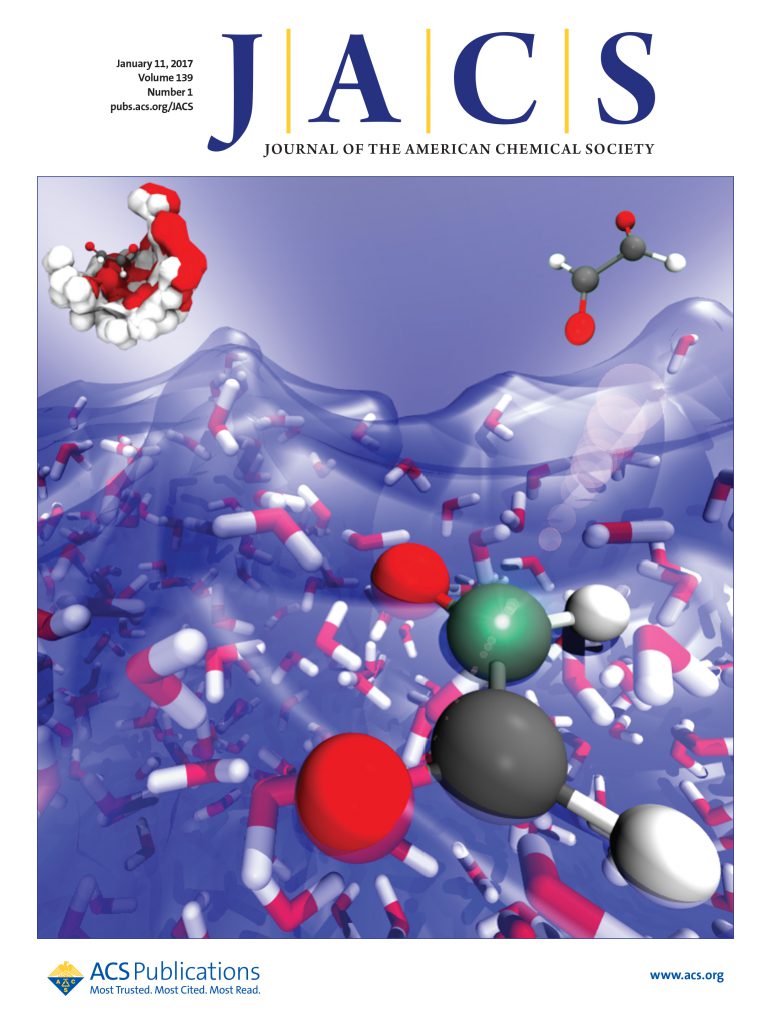Uncovering the Pressure-Dependent Mechanism of CO2 Hydrogenation to Methanol on Ga-Promoted Cu/ZrO2 Using Operando Modulation-Excitation DRIFTS.
IF 14.4
1区 化学
Q1 CHEMISTRY, MULTIDISCIPLINARY
引用次数: 0
Abstract
The synthesis of methanol via CO2 hydrogenation is attracting significant interest, with Cu-based catalysts currently leading this promising approach. Incorporating Ga and Zr promoters further enhances catalyst performance by suppressing the competing reverse water-gas shift (RWGS) reaction. However, their precise mechanistic roles and the identities of key reaction intermediates remain debated, which may be the key for catalyst design and process optimization. In this study, we extend operando modulation-excitation spectroscopy coupled with diffuse reflectance infrared Fourier transform spectroscopy and mass spectrometry (ME-DRIFTS-MS) to investigate CO2 hydrogenation over Ga-promoted Cu/ZrO2 under varying industrially relevant pressures up to 50 bar. Our results indicate that methanol formation proceeds predominately via the formate pathway with formate (HCOO*) and methoxy (CH3O*) as pivotal intermediates. Additionally, we demonstrate that the rate-determining step is strongly dependent on the pressure and temperature, ultimately dictated by the local abundance of adsorbed hydrogen (H*) and gaseous H2O. Ga facilitates hydrogen adsorption, accelerating HCOO* hydrogenation to CH3O* and preventing its decomposition to CO. Notably, CH3O* conversion to CH3OH occurs via a water-assisted pathway rather than direct hydrogenation, explaining previously unclear correlation between Cu dispersion and catalytic activity. These mechanistic insights highlight the potential of optimizing reaction conditions─especially lower operating temperatures and controlled water cofeed─to significantly enhance methanol selectivity over Cu-based CO2 hydrogenation catalysts.利用Operando调制-激发漂移揭示ga促进Cu/ZrO2上CO2加氢制甲醇的压力依赖机理。
通过二氧化碳加氢合成甲醇引起了极大的兴趣,目前以铜基催化剂为主导的这一有前途的方法。添加Ga和Zr促进剂通过抑制竞争性的逆水气转换(RWGS)反应进一步提高催化剂性能。然而,它们的确切机制作用和关键反应中间体的身份仍然存在争议,这可能是催化剂设计和工艺优化的关键。在这项研究中,我们扩展了operando调制激发光谱,结合漫反射红外傅立叶变换光谱和质谱(ME-DRIFTS-MS)来研究在不同的工业相关压力(高达50 bar)下,ga促进Cu/ZrO2上的CO2加氢。我们的研究结果表明,甲醇的生成主要通过甲酸途径进行,甲酸(HCOO*)和甲氧基(ch30 *)是关键的中间体。此外,我们证明了速率决定步骤强烈依赖于压力和温度,最终由局部吸附氢(H*)和气态H2O的丰度决定。Ga促进氢吸附,加速HCOO*加氢成ch30 *,阻止其分解成CO。值得注意的是,ch30 *转化为CH3OH是通过水辅助途径而不是直接加氢,这解释了之前Cu分散与催化活性之间不明确的相关性。这些机理的见解突出了优化反应条件的潜力,特别是降低操作温度和控制水共进,以显着提高甲醇选择性比cu基CO2加氢催化剂。
本文章由计算机程序翻译,如有差异,请以英文原文为准。
求助全文
约1分钟内获得全文
求助全文
来源期刊
CiteScore
24.40
自引率
6.00%
发文量
2398
审稿时长
1.6 months
期刊介绍:
The flagship journal of the American Chemical Society, known as the Journal of the American Chemical Society (JACS), has been a prestigious publication since its establishment in 1879. It holds a preeminent position in the field of chemistry and related interdisciplinary sciences. JACS is committed to disseminating cutting-edge research papers, covering a wide range of topics, and encompasses approximately 19,000 pages of Articles, Communications, and Perspectives annually. With a weekly publication frequency, JACS plays a vital role in advancing the field of chemistry by providing essential research.

 求助内容:
求助内容: 应助结果提醒方式:
应助结果提醒方式:


